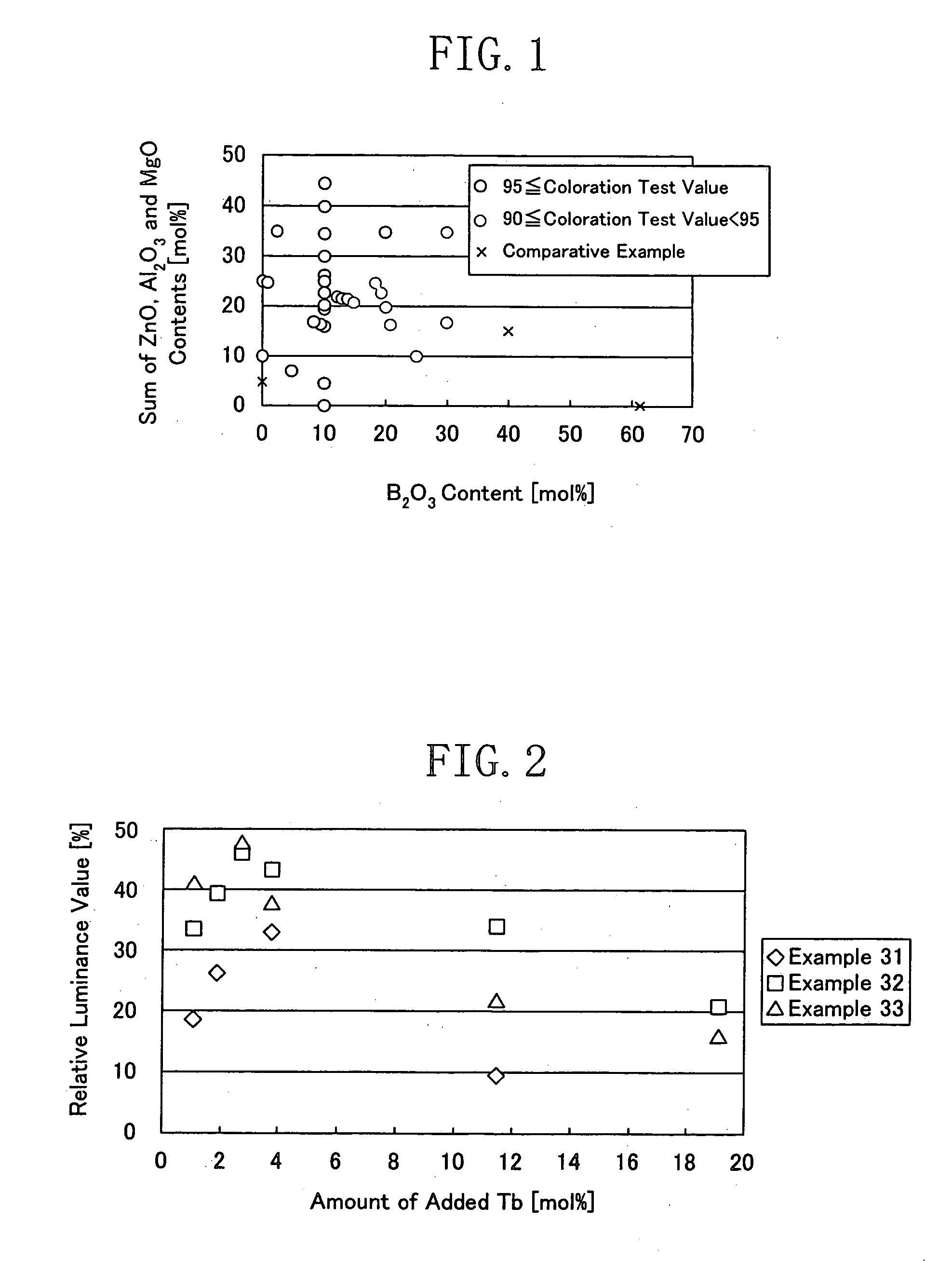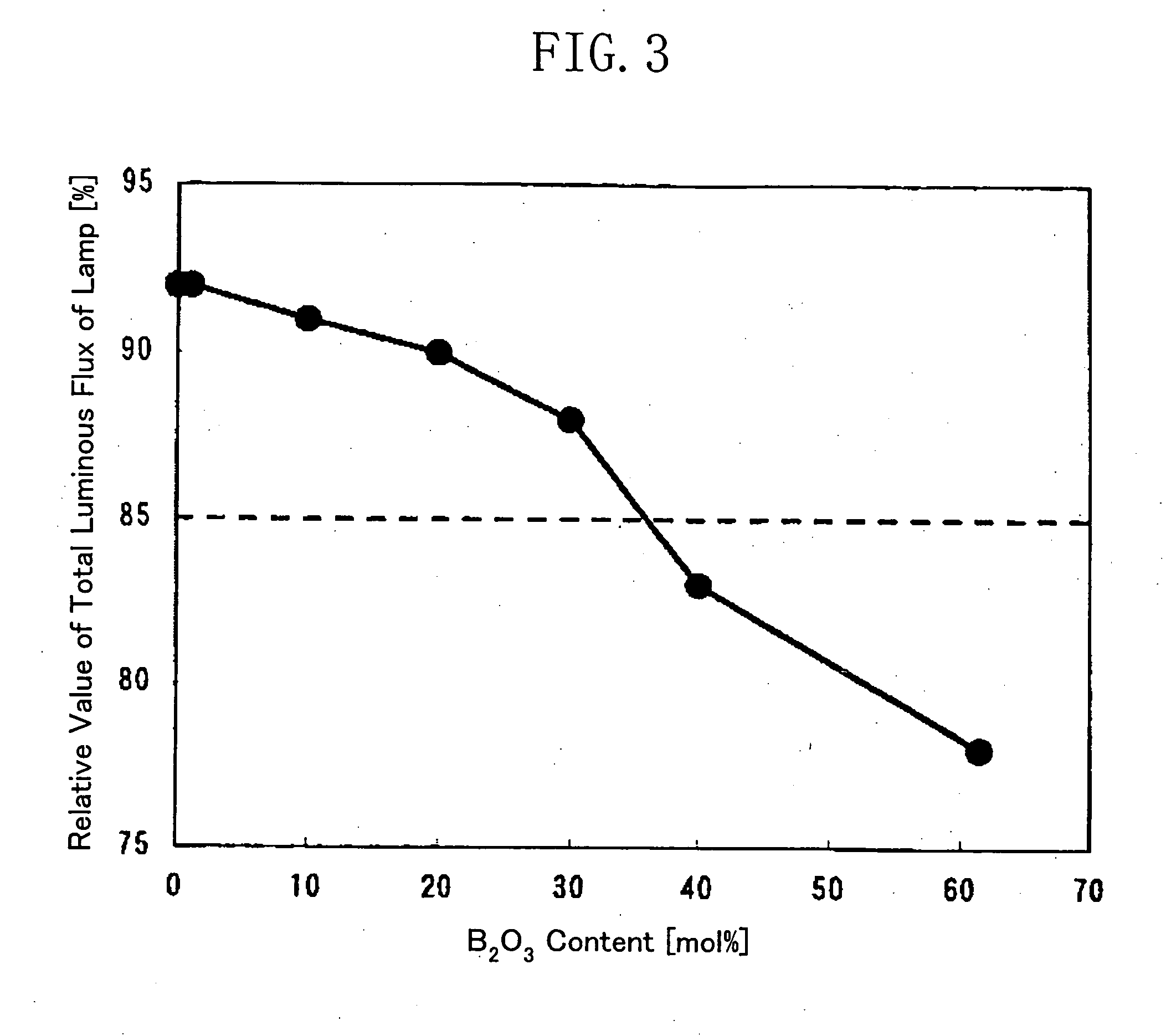Fluorescent device, fluorescent lamp and glass composite
- Summary
- Abstract
- Description
- Claims
- Application Information
AI Technical Summary
Benefits of technology
Problems solved by technology
Method used
Image
Examples
embodiment 2
[0058] An effect of a SiO.sub.2 content in a phosphor adhesive glass composite of the present invention will be described hereinafter. FIG. 8 shows the compositions and evaluation results of phosphor adhesive glass composites of Examples 7 through 9 and Comparative Example 3.
[0059] As obvious from FIG. 8, all of glass transition temperatures of Examples 7 through 9 fell within the temperature range suitable for a process for manufacturing a fluorescent lamp, and the values of coloration tests thereon exceeded 95. Thus, the glass composites of Examples 7 through 9 are effective for phosphor adhesion.
[0060] The glass transition temperature of Comparative Example 3 is 739.degree. C. so that the glass composite is not softened even in a glass processing process step such as tube bending. Therefore, this glass composite is not effective for phosphor adhesion.
[0061] SiO.sub.2 is a glass-forming oxide and is preferably contained in the glass composite to obtain a stable glass composite. Ho...
embodiment 3
[0062] An effect of the total content of SiO.sub.2 and B.sub.2O.sub.3 in a phosphor adhesive glass composite of the present invention will be described hereinafter. FIG. 9 shows the compositions and evaluation results of phosphor adhesive glass composites of Examples 10 through 12 and Comparative Examples 4 and 5.
[0063] As obvious from FIG. 9, all of glass transition temperatures of Examples 10 through 12 fell within the temperature range suitable for a process for manufacturing a fluorescent lamp, and the values of coloration tests thereon exceeded 95. Thus, the glass composites of Examples 10 through 12 are effective for phosphor adhesion.
[0064] After rapidly cooled, both of the compositions of Comparative Examples 4 and 5 were devitrified into a crystalline state. Glass composites hardly cause softening in a crystalline state. Thus, the use of Comparative Example 4 or 5 as a phosphor adhesive glass composite may cause the spalling-away of a phosphor film in a fluorescent lamp.
[00...
embodiment 4
[0066] An effect of the ZnO content in a phosphor adhesive glass composite of the present invention will be described hereinafter. FIG. 10 shows the compositions and evaluation results of phosphor adhesive glass composites of Examples 13 through 16 and Comparative Example 6.
[0067] As obvious from FIG. 10, all of glass transition temperatures of Examples 13 through 16 fell within the temperature range suitable for a process for manufacturing a fluorescent lamp, and the values of coloration tests thereon exceeded 95. Thus, the glass composites of Examples 13 through 16 are effective for phosphor adhesion.
[0068] After rapidly cooled, the composition of Comparative Example 6 was devitrified into a crystalline state. Glass composites hardly cause softening in a crystalline state. Thus, the use of Comparative Example 6 as a phosphor adhesive glass composite may cause the spalling-away of a phosphor film in a fluorescent lamp.
[0069] ZnO contributes to the lowering of the glass melting poin...
PUM
 Login to View More
Login to View More Abstract
Description
Claims
Application Information
 Login to View More
Login to View More - R&D
- Intellectual Property
- Life Sciences
- Materials
- Tech Scout
- Unparalleled Data Quality
- Higher Quality Content
- 60% Fewer Hallucinations
Browse by: Latest US Patents, China's latest patents, Technical Efficacy Thesaurus, Application Domain, Technology Topic, Popular Technical Reports.
© 2025 PatSnap. All rights reserved.Legal|Privacy policy|Modern Slavery Act Transparency Statement|Sitemap|About US| Contact US: help@patsnap.com



